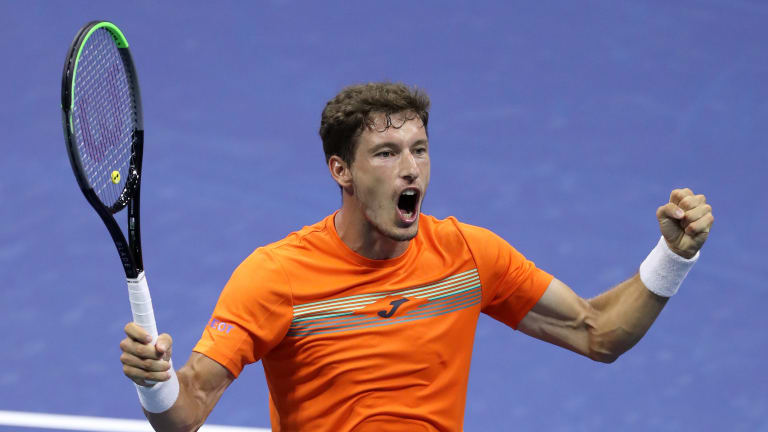Rarely in contemporary tennis will you see a style contrast as clear-cut as the one seen in tonight’s US Open quarterfinal between Pablo Carreno Busta and Denis Shapovalov. Call it conservator versus creator; or, more crudely, defense against offense. On this occasion, against sustained attack, Carreno Busta held down the fort, taking four hours and eight minutes to win this match, 3-6, 7-6 (5), 7-6 (4), 0-6, 6-3.
In Chris Lewitt’s book, “The Secrets of Spanish Tennis,” Alberto Lopez, a longstanding coach, articulates that country’s philosophy towards training and competition: “The most important thing is the mentality. We are really fierce. . . This is our game.”
The 29-year-old Carreno Busta personifies that superbly. His deep groundstrokes and counterpunching skills have taken him as high as world No. 10. Three years ago, he reached the semifinals in New York, a run that included a 7-6, 7-6, 7-6 win over Shapovalov in the round of 16.
While Carreno Busta largely hunkered down, drawing extensively on his excellent side-to-side patrolling skills, Shapovalov buzzed like a bumblebee. The Canadian left-hander lives for the chance to open up the court and strike big, sharp shots off both sides. Added to this is an appetite for volleying – 52 of 70 at the net on Tuesday night – and a lefty serve that has moments of effectiveness – 26 aces. The serve also remains a work in progress, evidenced this evening by 11 double-faults. The most painful came at 2-3, 30-40 in the fifth set, an error that handed Carreno Busta the conclusive service break. It's a tough moment,” said Shapovalov. “I was in that match, I had a good chance to win it. I was almost in every set. Very frustrating right now.”
Technically, this match was settled in that final set. In another sense, it was decided in the second and third sets. Despite having his serve broken in the opening game of the match, Shapovalov had sizzled through the first set, taking it 6-3 in 30 minutes. Surely he was hopeful the good tennis would continue and he could run Carreno Busta off the court, the way he had done in the previous round versus another formidable counterpuncher, David Goffin.
But while the Canadian sought to treat the court like a hockey rink, over the course of the next two sets, Carreno Busta turned it into a trench – and that is a compliment. He began to move a few steps forward to hit his groundstrokes, which took just enough time away from Shapovalov to press him into mistakes. And while the location of Shapovalov’s lefty serve continued to vary, certainly the Spaniard become more adept at fielding it during this part of the match.
“But at the beginning of the match I was very nervous,” said Carreno Busta. “It was very easy for him I think. After that, the match was different, very different. I start to return his serve. I serve better. I push a little bit more from the baseline. I play inside the court. I trying to be aggressive.”
